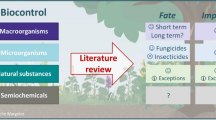Abstract
Microbial cultures were isolated from soil exposed to dimethoate, an organophosphorus insecticide. The isolate that showed maximum degradation of dimethoate was identified as Brevundimonassp. MCM B-427. The curve relating biomass accumulation and degradation revealed that aeration appeared to enhance growth rather than degradation. For optimization of environmental factors, a 24 factorial experimental design was used, wherein four factors namely pH, temperature, inoculum density and aeration condition were varied simultaneously. The interaction between the factors was analyzed using MINITAB package. Degradation of dimethoate was affected by a large number of factors interacting in a complex way. Six two-way and two three-way interactions of various environmental factors were found to be statistically significant. In all the two-way interactions, the effect of one factor was more pronounced when the other was at its optimum. The three-way interactions revealed that optimization of pH, inoculum size and aeration was more critical at 40 °C than at 30 °C.
The results imply the importance of studying interactions of parameters rather than optimizing individual parameters one by one. These results demonstrate complexity of the interaction and thereby imply the need for better experimental and statistical models.
Similar content being viewed by others
References
Achary, A., Hariharan, K.A., Bandhyopadhyaya, S., Ramachandran, R. & Jayraman, K. 1997 Application of numerical modelling for the development of optimized complex medium for D-hydantomase production from Agrobacterium radiobacter NRRL B 11291 Biotechnology and Bioengineering 55, 148–154.
Andreozzi, R., Ialongo, G., Marotta, R. & Sanchirico, R. 1999 The thermal decomposition of dimethoate. Journal of Hazardous Material 15, 283–294.
Bhushan, R., Thaper, S. & Mathur, R.P. 1997 Accumulation pattern of pesticides in tropical fresh waters. Biomedical chromatography 11, 143–150.
Box, G.P., Hunter, W.G. & Hunter, J.S. 1978 Statistics for Experiments: An Introduction to Design, Data Analysis and Model Building. New York: John Wiley and Sons Inc.
Davies, L. 1993 Effciency in Research, Development and Production: the Statistical Design and Analysis of Chemical Experiments. Cambridge: Royal society of chemistry.
Deshpande, N.M., Dhakephalkar, P.K. & Kanekar P.P. 2001 Plasmid mediated dimethoate degradation in Ps. aeruginosa MCM B 427. Letters in Microbiology 33, 275–279.
Gawande, B.N. & Patkar, A.Y. 1998 Application of factorial designs for optimization of cyclodextrin glycosyltransferase production from Kiebsiella pneumoniae AS-22. Biotechnology and Bioengineering 64, 168–173.
Gawande, B.N., Singh, R.K., Chauhan, A.K., Goel, A. & Patkar, A.Y. 1998 Optimization of cyclomaltodextrin glucanotransferase production from Bacillus rmus. Enzyme and Microbial Technology 22, 288–291.
Hasan, H.A. 1999 Fungal utilization of organophosphate pesticides and their degradation by Aspergillus flavus and A. sydowii in soil. Folia Microbiology 44, 77–84.
Hassal, A.K. 1990 Organophosphorous insecticides. In The Biochemistry and Uses of Pesticides. pp.81–124. London: ELBS publication.
Hounsa, C.G., Aubry, J.M., Dubourguier, H.C. & Hornez, J.P. 1996 Application of factorial and Doehlert designs for optimization of pectate lyase production by a recombinant E.coli. Applied Microbiology Biotechnology 45, 764–770.
Jaffery, F.N., Chawla, G., Kakkar, P., Misra, V., Soni, R., Vishwanath, P.N. & Ray P.K. 1989 Toxicology Data Handbook, vol III. pp.262–267. Lucknow: Indian Toxicology Research Center.
Kreig, N.R. & Holt, J.G. 1984 Gram-Negative Aerobic Rods and Cocci. In Bergey 's Manual of Systematic Bacteriology, vol. I. pp. 141–199. Baltimore: Williams and Wilkins.
Kumar, S., Mukerji, K.G. & Pal, R. 1996 Molecular aspects of pesticide degradation by microorganisms. Critical Reviews in Microbiology 22, 1–26.
Lee, S.L. & Chen, W.C. 1997 Optimization of medium composition for the production of glucosyltransferase by Aspergillus niger with response surface technology. Enzyme Microbiology Biotechnology 21, 436–440.
Marin, S., Sanchis, V., Saenz, R., Ramos, A.J., Vinas, I. & Magan N. 1998 Ecological determinants for germination and growth of some Aspergillus and Penicillum spp.from maize grain. Journal of Applied Microbiology 84, 25–36.
Mathur, S.C. 1992 The pesticides industry in India. In Chemical Weekly Annual. pp. 185–189. New Delhi: Pesticide Association of India.
Montgomery, D.C 1976 Introduction to factorial experiments. In Design and Analysis of Experiments. New York: John Wiley & Sons.
Sneath, P.H.A. 1986 Endospore forming Gram-positive Rods and Cocci In Bergey 's Manual of Systematic Bacteriology, vol. II, eds. Sneath, P.H.A., Mair, N.S., Sharpe, M.E. & Holt, J.G. pp. 1104–1207. Baltimore: Williams and Wilkins.
Srivastava, M.K. & Raizada, R.B. 1996 Developmental effect of technical dimethoate in rats: maternal and fetal toxicity evaluation. Indian Journal of Experimental Biology 34, 329–333.
Thaper, S., Bhushan, R. & Mathur, R.P. 1995 Degradation of organophosphorous and carbamate pesticides in soils–HPLC determination. Biomedical chromatography 9, 18–22.
Zhu, Y., Knowl, W., Smits, J.P. & Bol, J. 1996 Fractional factorial design used for the production of nuclease P1 by Penicillum citrinum in solid state fermentation. Enzyme Microbiology Biotechnology 18, 108–112.
Author information
Authors and Affiliations
Rights and permissions
About this article
Cite this article
Deshpande, N., Sarnaik, S., Paranjpe, S. et al. Optimization of Dimethoate Degradation by Brevundimonas sp. MCM B-427 Using Factorial Design: Studies on Interactive Effects of Environmental Factors. World Journal of Microbiology and Biotechnology 20, 455–462 (2004). https://doi.org/10.1023/B:WIBI.0000040378.54329.18
Issue Date:
DOI: https://doi.org/10.1023/B:WIBI.0000040378.54329.18




